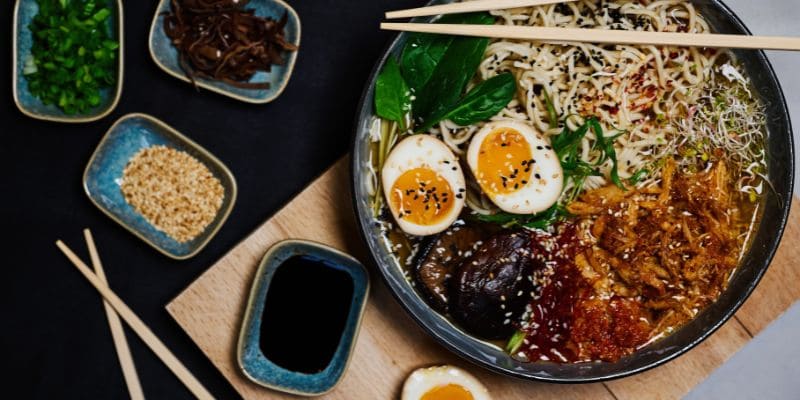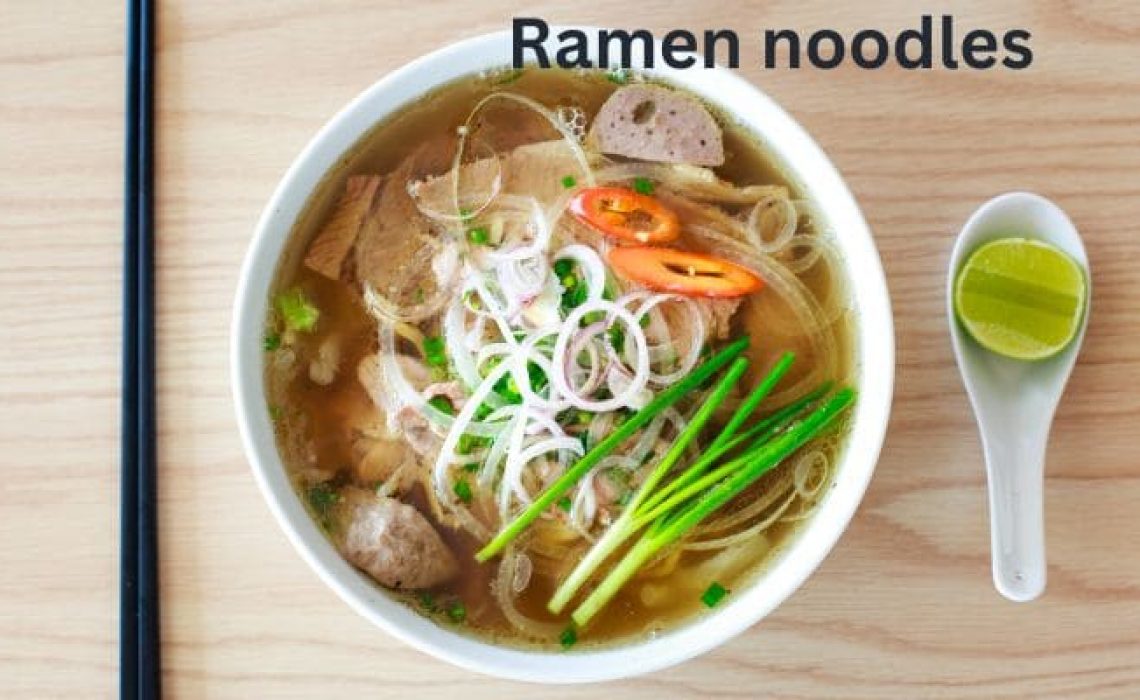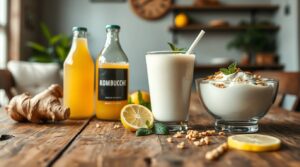Ramen noodles are a popular form of quick noodle throughout the world.
Due to their low cost and short preparation time, they appeal to individuals on a budget or with limited time.
Although instant noodles are convenient, it is unclear if they should be consumed on a regular basis.
There are different sizes and shapes of ramen. It can be thick, thin, lace, straight, or curly.
This article examines instant noodles objectively so that you may determine if they can be included in a healthy diet.
Table of Contents
Toggle1. Is Ramen noodle good for health?
Despite being low in calories, it has lack fibre and proteins which is important for health.
It provides some nutrients like iron vitamins B and manganese but lacks other many important nutrients like vitamin A, vitamin C, Vitamin B12, calcium, magnesium, and proteins.
A list of some side effects of ramen noodles:
-
In women, eating ramen raises the risk of metabolic syndrome.
Regardless of their overall health and level of physical activity, women who ate instant noodles at least twice per week were 68% more likely to develop metabolic syndrome. According to doctors, ramen has processed ingredients, a high sodium content, and a high level of saturated fat, which can lead to high blood pressure, high blood sugar, stroke, diabetes, and heart disease.
-
Ramen stresses the digestive system.
Your stomach can no longer digest the processed pasta after two hours. This interferes with normal digestion Tributyl hydroquinone (TBHQ), a difficult-to-digest petroleum chemical, is used to preserve ramen. It is also present in varnishes and pesticides. The instant noodles will stay longer if your system processes them for a longer period of time. The longer your body is exposed to these toxins, the more difficult it is for your body to absorb nutrients from other foods. Your body will eventually expel them through your digestive system. However, if you feel nausea, vomiting, ringing in the ears, or delirium, it could be due to TBHQ exposure.
-
Reman can increase the risk of heart disease.
High blood pressure brought on by sodium increases the risk of a heart attack or stroke. It’s probably not a good idea to overdose on salt that day because ramen noodles have 1820 milligrammes of sodium or approximately two-thirds of the U.S. Food and Drug Administration’s suggested daily intake. The risk increases as you eat more.
-
The consumption of ramen may lead to weight gain.
One package of ramen packets has 14 grammes of saturated fat, which is equivalent to 40% of the daily saturated fat intake that is advised. They do not include a significant amount of protein, fibre, vitamins, or minerals. This ready-to-eat snack could make you feel full, but it’s not very nutritious and has few calories.
-
Ramon is toxic to the liver and should be avoided.
Added chemicals and artificial preservatives, sweeteners, and flavours are hard for the liver to handle, and so are many of the foods that fall into this category. When there is too much work for the liver to handle, it resorts to storing fat in other parts of the body. Excess fat in the body can cause inflammation and eventual organ failure if left unchecked. Water retention and abdominal distention are additional symptoms of abnormal liver function.
Note: What is TBHQ
TBHQ is a preservative that is also known as tertiary butylhydroquinone. This means that it is used during storage to extend the shelf life of food. Specifically, it is a synthetic antioxidant used to preserve fatty or fatty foods.
TBHQ is sprayed onto food or food containers to prevent odours or changes during storage. It is found, among other things, in cosmetics and nail products. The main attraction of preservatives like TBHQ is that they extend the shelf life of foods, thus reducing food waste and waste.
TBHQ’s antioxidant properties remove oxygen from food, preventing spoilage or adverse health effects. The FDA and the European Food Safety Authority (EFSA) consider TBHQ generally safe at low doses. In addition, the FDA and EFSA limit the percentage of TBHQ allowed in foods to less than 0.02% of total fats and oils.
TBHQ is found in many processed foods, such as instant noodles, crackers, and frozen foods. It can also be found in many fast food restaurants such as McDonald’s Chicken. You can add items that you need to store on a shelf or in the fridge.
2. Nutrition Fact of Ramen
- Fat 1 serving (43 grams) – 7g, saturated fat – 3.2 gram
- Cholesterol – 0 mg
- Sodium – 875.5 mg
- Potassium – 77 mg
- Carbohydrate – 27g
- Dietary fibre – 1g
- Sugar – 0.7 gram
- Protein – 4.5 gram
- Vitamin C – 0%
- Calcium – 1%
- Vitamin D – 0%
- Iron – 9%
- Vitamin B6 – 0%
- Magnesium – 2 %
- Cobalamin – 1%
Source: USDA
3. Is Ramen a Japanese and Korean dish?
A Japanese dish with an umami taste, ramen is created using noodles and a variety of other ingredients. It takes an entire day to produce exceptional dishes like tonkatsu, in contrast to ramen, which can be eaten immediately after it has been made since the materials and preparation are so complicated.
It’s possible that some westerners are accustomed to the existing kind of ramen, yet the new ramen is not only more delicious but is also frequently regarded as “genuine” ramen. Umami, saltiness, and scarcity are the hallmarks of today’s ramen.

4. Ramen varieties
Over the course of its history, ramen has developed into a wide variety of dishes, many of which are considered to be regional specialities.
These are the most common ramen dishes:
- Tonkotsu is a popular meal that is prepared by cooking pork for a number of hours in a pot of boiling water.
- The miso flavour gives “miso ramen” its distinctive taste, as the name suggests. It is possible to prepare it with a variety of misos, the most common of which are white miso, red miso, and grass miso.
- “Shoyu ramen”, which literally translates to “soy ramen,” was the first type of ramen to be created in Japan. Soy ramen can be prepared in a variety of ways, but the dish is never complete without a drizzle of soy sauce.
- Cooking salty items like seafood or chicken results in a dish known as “shio ramen”, which literally translates to “salty ramen.”
- “Tsukemen” is substantial bags that take in food rather than drink water. Before being served, each bag is submerged in the broth for a moment.
5. What are the ingredients used to make ramen?
The basic ingredients used for preparing ramen noodles are wheat flour, water, salt and kansui. It is also based on meat and fish, as well as vegetables and meat. It varies, especially on a regional basis, with various ingredients and toppings. Mineral water is a type of alkaline mineral water that contains sodium carbonate, usually potassium carbonate, and sometimes small amounts of phosphoric acid.
6. What exactly is a kansui?
Kansui is a naturally occurring alkaline mineral water rich in potassium and sodium carbonate. This is the secret ingredient that distinguishes ramen noodles from other types of noodles and is responsible for their characteristic yellow colour and firm texture. This item is notoriously difficult to track down, but you can make wonderful homemade ramen noodles in its place.
Kansui is a unique ingredient in ramen noodles and comes from Inner Mongolia, where some lakes are rich in minerals and the water is ideal for making noodles.
Conclusion
Occasional use of reman noodles isn’t detrimental to health, Hence, we should avoid regular consumption as that lead to poor health quality.
Sometimes we can use it in a healthy way by adding vegetables to it or we can switch to fresh ramen noodles as well, which are traditional Chinese or Japanese noodles. It uses nutritious ingredients like eggs, ducks meat and vegetables and is served in soup form.










2 thoughts on “10 Facts About Ramen Noodles | Japanese dish”
Pingback: 10 Facts About Pho| Vietnamese dish - Easy Life
Pingback: 10 Most Popular Chinese Food |Chinese dishes - Easy Life